Fly tying instruction Simple Dry Fly
How to Tie the Simple Dry Fly
Fly tying instruction Simple Dry Fly. This technique - almost forgotten these days - lets you use larger hackles that most tiers never use, unless they tie lots of streamers. Without it, almost two thirds of the hackles in a normal cape go to waste. A very nice side effect is that you produce a fly that imitates natural flies really well.
1) Clamp the hook correctly, depending on your vise. When using a Norvise like the one on this photograph, take care to align the hook properly.
.
.
2) Tie on your thread and tie nice tight touching turns from the eye all the way to the beginning of the hook´s bend. This will contribute to the quality and the durability of your fly.

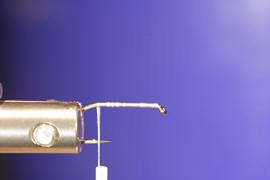
3) Dub sparsely about two thirds of the hook from the bend towards the eye. You may use brown, grey, or olive dubbing.
.
.
4) Pick a large hackle from the rear end of your cape. Any color can be used, natural hackles are better than dyed ones.
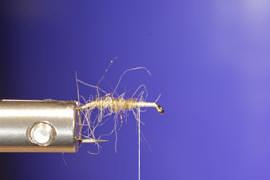

5) Now stroke the fibers against their natural direction, taking care not to strip them from the quill!!!
.
6) Tie in your hackle right at the tips of your fingers. The rounded part of the hackle protrudes beyond the hook bend. If you are right-handed, you´ll have to wrap the first three to four turns with your left hand. The right one will hold the hackle to the hook at the eye
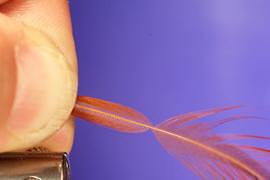

7) Now pull back the front end of your quill and snip it off as close to the hook as possible. This will leave a few fibers pointing forward which will serve as antennae. Next, snip off the back end at the "rounded" part, taking care not to cut any of the fibers pointing forward, needed to form the rounded part.
.
.
8) Secure the entire structure with a few turns against slipping. A knot is not necessary and would only add useless weight.

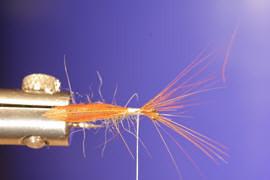
9) Next, tie in a (smaller) hackle and one strand of peacock herl
.
.
10) and wrap first your peacock herl...

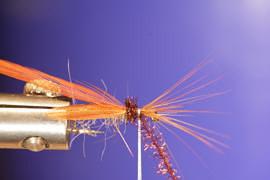
11) ...and then your hackle forward towards the eye.. Tie down and snip off hackle and herl.
.
.
12. Whipfinish and - done


Besides its good imitative properties and the fact that it lets you use hackles that would otherwise go to waste, a big advantage of this fly is that it doesn´t take more than about two minutes to tie. If you wish, you may stabilize the wing with a little thinned silicone. I don't, because it´s so easy and quick to tie. Hope you like this fly tying instruction. Enjoy fly tying and fishing your own! Wolfgang

A few words about using permanent markers. No matter which make, solvents are always included in these markers. If, after coloring your thread, the head knot is done quickly, the use of head cement at the knot is not necessary. The solvents evaporate and leave behind only the dye or pigment. This will suffice to stabilize your whipfinish.
.
.
Fabisch fly fishing english
.
Fabisch Fliegenfischen german
- Wolfgang Fabisch
- Nürnberger Str. 45
- 90542 Eckental / Germany
- Phone 011 49 9126 288640
- Fax 011 49 9126 288643
- Copyright: Wolfgang Fabisch
.
.